- February 3, 2022
- Posted by: Stef Lantin
- Category: Research Spotlight
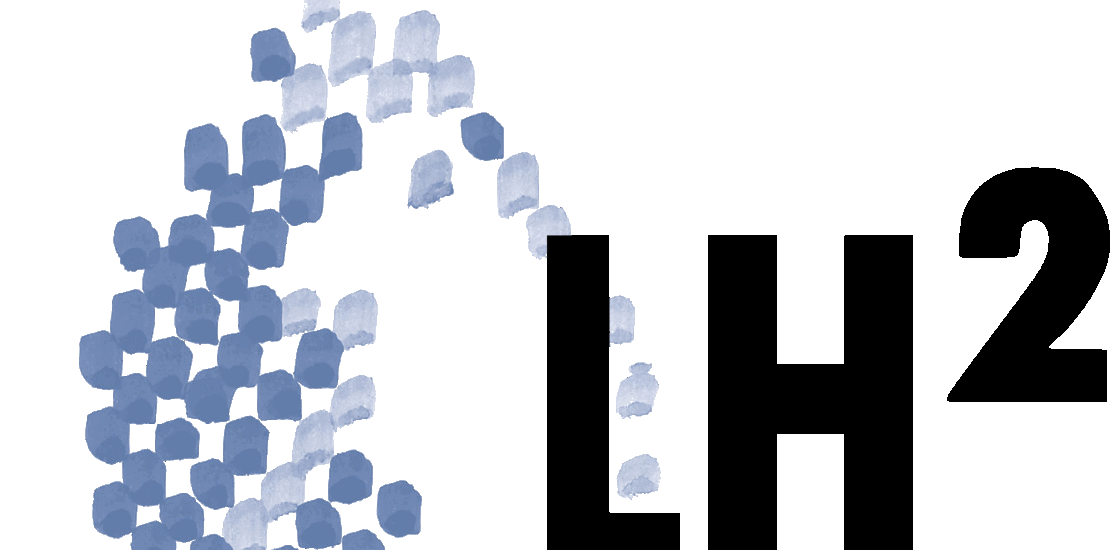
Department of Hydromechanics and Modelling of Hydrosystems (LH²) of the University of Stuttgart
The research group at the Department of Hydromechanics and Modelling of Hydrosystems (LH²) is part of the Institute for modelling Hydraulic and Environmental Systems of the University of Stuttgart. The department was founded in 2000, when Prof. Rainer Helmig took over as department director.
The aim of the group is to ensure close interdisciplinary work between the fields of research, teaching and lifelong learning courses, as well as technology transfer in the engineering sector.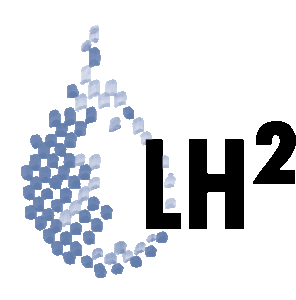
LH2 currently comprises around 30 members of different research fields, such as mathematics, physics, civil and environmental engineering and simulation technology.
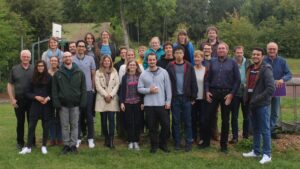
Fig 1: Picture of the LH2 team in 2019.
Research
At LH2, fundamental research and applied science are well balanced, both in a highly interdisciplinary international context. The aim is to ensure a close interaction of research, teaching and advanced training as well as technology transfer to engineering practice. The working group is combining theoretical and experimental research with numerical simulation of complex coupled physical processes. LH2 considers itself strongly connected to the fields of modelling hydrosystems and hydro-informatics, obtaining the necessary experimental support from, e.g. the Research Facility for Subsurface Remediation (VEGAS), located at the institute, as well as through cooperation with national and international partners.
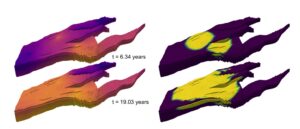
Fig 2: Norne reservoir oil production. Two-phase flow in porous media: Oil production simulation based on the Norne data set. Two injection wells inject water into an initially oil-saturated formation with isotropic heterogeneous permeability field. Two production wells produce oil. The grid is represented by a corner-point grid. Injection rates are approximated with a Peaceman well model. The figure is modified after Koch, Gläser, Weishaupt et al. (2020) / CC-BY-4.0 and is based on the simulation data of Schneider (2019).
Special emphasis is laid on the development and practical engineering application of simulation methods and techniques for describing single- and multi-phase flow and transport processes in the sub-surface and in porous and fractured-porous media. The various projects, in which LH2 is involved, deal with the single-phase flow of water or air, the two-phase flow of water and gas or contaminants (NAPL) as well as the isothermal and non-isothermal three-phase flow of water, gas and organic fluids, where particular attention is paid to multi-component transport processes and phase transitions of the components. Current research topics concern the development of special techniques and discretisation methods for multi-phase flow, upscaling / downscaling and multi-scale investigations, parameter identification, fracture-matrix systems, model coupling for various flow compartments (free flow / porous media) or data assimilation. A further subject of intensive study within the group is the coupling of flow with chemical or bio-chemical processes.
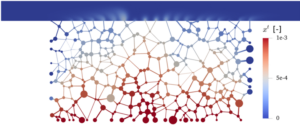
Fig 3: Tracer transport from a pore network into a free-flow channel. Coupled free-flow/pore-network model (single-phase flow): A tracer component is injected at the bottom of a randomly generated pore-network. It rises by advection and diffusion and finally reaches the adjacent free-flow channel, where the Navier-Stokes equations are solved. Since no external flow is imposed in the channel, the tracer spreads almost symmetrically to the left and to the right. More details on the fully monolithic coupled model and the simulation setup are given in Weishaupt et al. (2019). The source code is openly available at dumux-pub/weishaupt2019a.
One major tool is the open-source simulator DuMuX (www.dumux.org), based on the numerical platform denoted as DUNE. It was developed at LH2 and is being continuously extended and improved. DuMuX can be considered as the department’s research lab. The software and programming environment serves not only the work being carried out by doctoral researchers, but also students preparing their master’s or bachelor’s theses as a powerful base for their implementations or simulations. The development and maintenance of DuMuX, its provision for external users as well as user support, require a great deal of time and work, only possible with a committed team and experienced leadership.
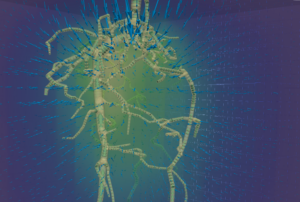
Fig 4: Root-soil interaction. Root water uptake simulation: Simulation of root water uptake by a lupine root system. Water flow in the surrounding soil is visualized by the vectors field. The lupine root system has been reconstructed from MRI data (Schröder (2014)). In the simulation, the root system geometry is approximated by a network of line segment (local root centre-line), visualized as tubes extruded with the local root radius. The root system is embedded into the three-dimensional soil domain by means of a mixed-dimension method. The mathematical model and the numerical method and is described in Koch et al. (2018).
There is a balanced relationship between basic and applied research. Due to intensive research on the topic of “porous media”, the University of Stuttgart has become an important centre of competence in this field.
The application areas of these research topics are, amongst others:
- Pollutant dispersion underground
- Thermally driven remediation technology
- Storage of CO2in deep geological formations
- End storage problems
- Methane migration from decommissioned mines
- Gas-water management in fuel cells
- Filters
- Drying and salinizing the ground
- Gas storage underground or flow and transport in vascular vessels and tissues in the body
International Projects
The research group of LH² is currently working on various international and interdisciplinary projects and the group’s work is also integrated into research associations at the University of Stuttgart.
- There is a strong collaboration and overlap with the Collaborative Research Centre (SFB) 1313 “Interface-Driven Multi-Field Processes in Porous Media – Flow, Transport and Deformation”, which is led by spokesman Prof. Rainer Helmig and funded by the German Research Foundation (DFG). SFB 1313 just started its second funding period from 2022 until 2025. The department is represented with 5 projects in the SFB.
- In the SimTech Cluster of Excellence “Data-Integrated Simulation Science”, the department is represented with 3 research projects. Rainer Helmig was a member of the Board of Directors of the Cluster of Excellence from 2018 to 2021.
- LH2 is involved in the International Research Training Group DROPIT with two research project.
- The National Water Supply is a long-term partner of the department, researching alternative resources to tackle the effects of climate change.
- The department also takes part in various collaborations with the Federal Office for Radiation protection, with whom it is currently working on modelling hydrodynamics and material transport in water-bound transport processes in radiation protection in terms of gaining clearance approval for weak radioactive substances.
- International and interdisciplinary research is extremely important at LH². Programmes of the DAAD – the German Academic Exchange Service – are often used to increase collaborations with students at other universities. The department is currently involved in a cooperation with the Ecole Nationale d’Ingénieurs de Tunis (ENIT) in Tunisia. The research groups at LH² and at ENIT are working together on an environmental application, investigating salinization processes in porous media where evaporation processes develop. Starting in February 2022, two ENIT students will visit LH2 and SFB 1313 for a period of six months to work on their final theses in the framework of the DAAD KOSPIE programme “Combined study and practical stays for engineers from developing countries”
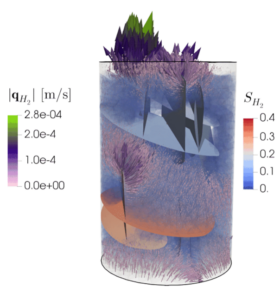
Fig 5: Two-phase flow in fractured porous media. Synthetic core sample experiment: The simulation shown in this figure mimics a two-phase flow experiment on a core sample of fractured rock. The figure shows the saturation and velocity of hydrogen as it migrates through a synthetic sample that contains a number of elliptical and randomly distributed fractures (generated with the fracture network generator Frackit). In this numerical model, the fractures are represented by two-dimensional geometries, and it is able to handle both highly permeable as well as blocking fractures. In the setting shown in the figure, the fractures are much more permeable than the surrounding medium, which causes hydrogen to be transported rapidly through the fracture network.
Education
One of LH2‘s primary aims is to provide comprehensive, high-quality interdisciplinary training, predominantly for students of the study programmes Environmental Engineering, Civil Engineering and Simulation Technology as well as the international master’s programmes WAREM (Water Resources Engineering and Management) and COMMAS (Computational Mechanics of Materials and Structures). In addition, the department aims to attract students from other disciplines such as mathematics, computer sciences or process engineering. The courses deal with the fundamentals of fluid mechanics, the modelling of hydrosystems, the description of exchange and transport processes in flows; more advanced lectures present the theory and numerics of flow and transport in porous media. In addition to the lectures, various seminars are organised in cooperation with other faculties, e.g. as part of SRC SimTech.
Current research is integrated in teaching as well as in bachelor and master projects with the aim of giving the graduates particularly well-founded expertise in the field of modelling flow in porous media, a rare educational feature.
LH2 is involved in a number of doctoral programmes. Together with the “International Graduate Program Environment Water” (ENWAT), established in 2001, these are the DFG graduate schools of the Cluster of Excellence Simulation Technology and of the International Research Training Groups NUPUS (2007 – 2016) and DropIT (since 2016) and of SFB 1313 (since 2018).
